4 Detailed Tutorials to Make a Small Room Seem Larger (with pictures)
Do you sometimes think you’re outgrowing your home? Did the rooms seem much bigger when you moved in? Whatever happened to all that space?
No. your home isn’t shrinking before your eyes. It just feels that way. If the cramped rooms in your house or apartment are reminding you all too often of the dimensions of your decorating budget, we have some ideas for you to change all that — without moving a wall or raising the roof. You can create the illusion of more space, and save the expense of that pricey addition.
I rounded up four of the easiest, most ingenious, and least expensive solutions ever found to the space-crunch problem.
One of these sleight of hand solutions may well be the answer to your space crunch. Or, if you’re really clever, you may put all four to work in your home.
Color
Focus attention on decorative elements (bright white woodwork, shutters, wicker furniture, pictures, etc.) by painting the walls a deep navy blue to make them visually recede. This creates an illusion of greater depth and the room feels bigger because the walls have, in effect, disappeared.
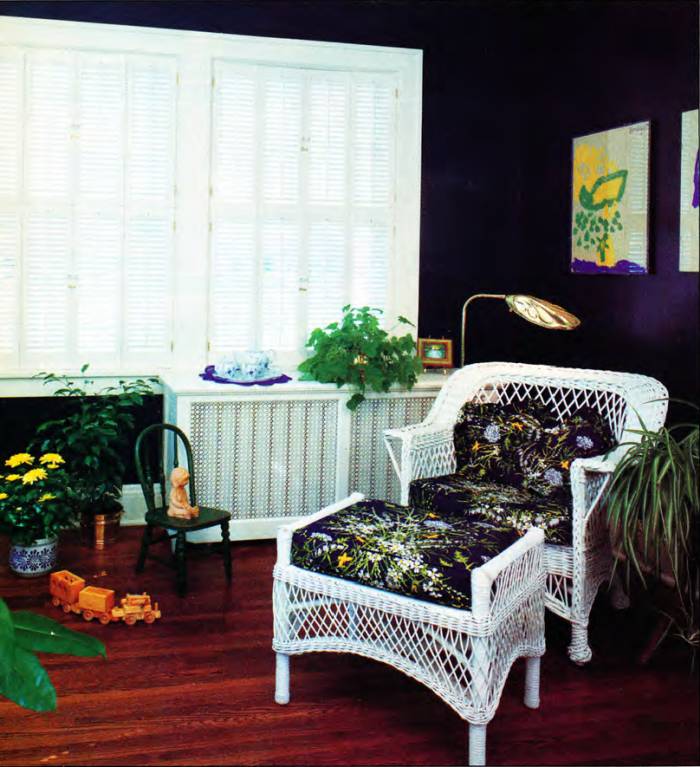
White walls can enlarge a room as well, but for different reasons. In this room a monochromatic color scheme of creamy off-white walls and furniture offers a sense of spaciousness through a minimum of clutter.
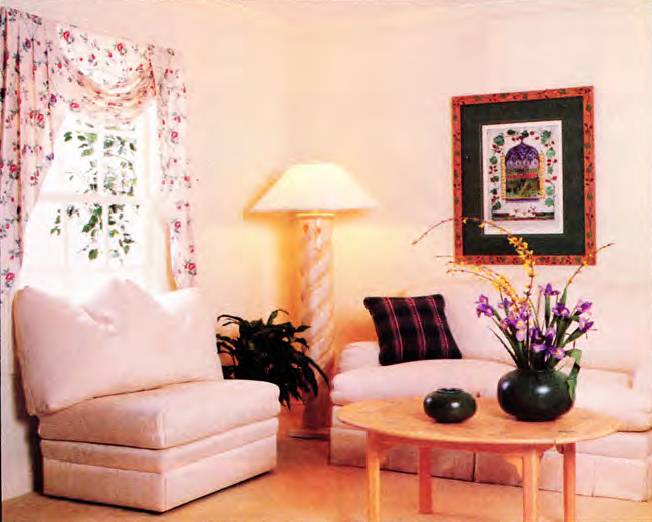
The most common technique for changing the apparent shape and size of a room is changing its color. Two gallons of paint, a few hours work, and presto! — you have a whole new look.
The lighter the color, the bigger the feel of the room, right? Well, not exactly. There‘s more to color than meets the eye.
For the last twenty years, the typical remedy for a room diagnosed as too small has been to paint everything (walls, ceilings, moldings) a dazzling white. But flat-out, pure white isn’t exactly a warm color, is it? Besides, it gets boring. Here are some alternatives.
Two alternatives to white
You want a bigger-looking room, but do you also want the color to lend warmth and visual interest? To set a mood? To complement your furnishings?
To begin with, keep in mind that if your rooms are making you feel claustrophobic, chances are it’s more than merely their size that’s bothering you. You may be reacting to a displeasing color scheme. That’s a snap to change.
Decorated tastefully and with an eye to maximizing the look of its space, you’ll feel more at ease, more likely to sit down in the room and enjoy yourself, stretch out and relax.
A very light color can be just as effective as white when it comes to your first requirement: creating the illusion of space. For a warmer, more intimate atmosphere, choose an off-white, a cream or ivory.
Remember the rule about clutter: it makes a room feel smaller. The same applies here. Don’t clutter your color scheme either. Paint everything — wall, ceilings, and woodwork — the same color. This approach works best if your carpet and furnishings are very light, too.
If you wish the color to assert itself a bit more — perhaps to harmonize with furnishings or to offer a muted back- ground for a particular accent color in the room, you can add a very pale tint and still preserve the illusion of more space. It’s the uniform lightness of the color scheme that lends the feeling of spaciousness.
But remember that the tint should be so light as to be almost imperceptible. Say, for instance, you add a hint of pink to the paint. You will sense its presence in the room — pink even in minute doses flatters skin tones and softens a room — but you wouldn’t call it a pink, or even a pinkish room. You would call it white.
My second suggestion may surprise you. Dark colors can open up a small room by making the walls appear to recede from your eye.
Caution: This technique takes confidence and a sure touch. It works only in rooms with lots of windows and light, and the higher the ceiling the better. Plus, the room should be able to accommodate a few fairly large pieces of furniture and artwork.
OK, the principle at work here is the same one you apply when buying clothes: Very dark colors tend to make you look thinner; bright colors have the opposite effect, drawing the eye immediately to them and to your body!
Paint the walls and ceiling a dark color, and watch them seem to recede behind those bold objects in the room. When this works, it works very dramatically. The walls and ceiling become backdrops to the objects in the room, rather than backstops for the eye, and you notice the objects rather than the walls.
Cool colors such as dark blue and dark green are particularly effective, especially if used on one wall only. Very deep reds and corals will accomplish the same thing as the cooler blues and greens, but red tones can have the reverse effect if you’re not careful to choose very dark shades. A bright red room or a bright blue room will both seem smaller than a dark red or dark blue room.
Deep-tone colors are more 60-70% expensive, compared to flat white latex. But when you compare these prices to the cost of that new addition…
Table 1: Warm Colors
These warm, cheerful colors make objects advance towards the eye so rooms appear smaller and furniture appears larger.
| Color | Effects | Overuse | Room Use |
|---|---|---|---|
| Warm Greys | Warm to neutral | Monotonous | Use with other colors |
| Yellows | Cheery, lively | Alarming | Bedroom, living room |
| Oranges | Can make people leave an area | Alarming | One wall |
| Reds, corals | Stimulates conversation, activity | Distracting, frantic | Dining, living, or conversation areas |
| Deep reds | Enticing, romantic | Intense | Dining, living, or conversation areas |
| Browns | Restful | Confining, dark | Study or use with other colors |
Table 2: Cool Colors
These cool, restful colors make objects recede from the eye so rooms appear larger and furniture appears smaller.
| Color | Effects | Overuse | Room Use |
|---|---|---|---|
| Cool greys | Heavy, melancholy | Chilling | Use with other colors |
| Greens | Relaxing, sedative | Melancholy, sad | Study or quiet areas |
| Blues/Turquoises | Restful, increases ability to concentrate | Melancholy, sad | Study or quiet areas |
| Mauves, purples | Calming, soothing | Depressing | Bedroom |
Table 3: Neutral Colors
These colors recede into the background and the eye focuses on the furniture and objects in a room.
| Color | Effects | Overuse | Room Use |
|---|---|---|---|
| White | Blue-whites are cool, yellow-whites are warm | Stark | Any room |
| Black | Dramatic | Cold, closed-in | Use with other colors |
| Taupes | Tend to be warm | Monotonous | Any room, use with other colors |
Moldings
Furniture that seemed too big for this room when the walls were white, fell right when “anchored” to deep green wallpaper bordered by moldings, and white paint. This scheme lends interest and organization to the room by giving the eye directions for where to go next.
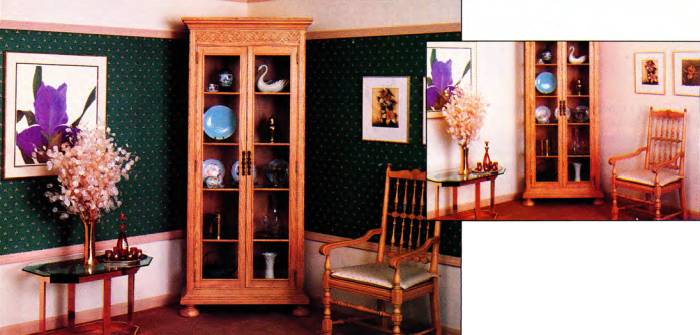
Transform a claustrophobic hallway with moldings. Note the placement of moldings just below the eye level, and the use of twin strips of wood separated by white space.
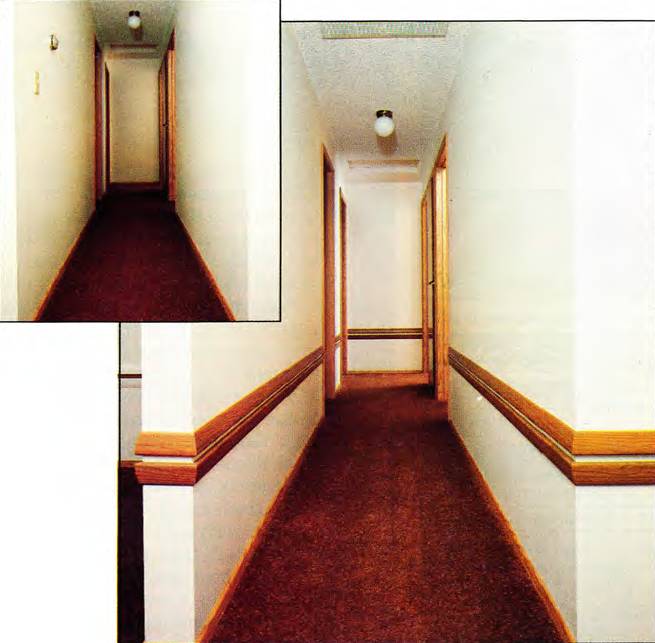
No room should be without moldings.
Wait a minute! Won’t they just add to the clutter? Won’t they make an already small living room seem even tinier?
I’m not contradicting myself. Moldings have just the opposite effect. They accent and enhance a room‘s natural gifts, its scale and proportion, its immaculate lines and no-nonsense right angles.
Trace the lines where walls meet ceiling or floor with a simple wood molding, and you will not only add character and distinction to the room — you will also have tricked the eye into believing the room is bigger.
Really!
What’s more, moldings are inexpensive – be it a plain picture molding or a fancier crown molding. And you don’t need a master carpenter to install them. You can do it yourself. Check out my article about installing finish trim.
Where to install a chair rail
The most dramatic room-enlarging effect is created by a simple molding called a chair rail. The name comes from its original purpose, to protect walls, especially in dining rooms, from scrapes caused by chairs backed into them.
Any room in the house may be beautified by a chair rail, which is simply a strip of wood that horizontally bisects a room. The uninterrupted horizontal line entices the eye and thus seems to elongate the room. Very clever — and very easy to accomplish.
Your chair rail should be located just above or below major pieces of furniture (so they don’t hide it or interrupt the line). Pick a spot one third of the distance from the floor to the ceiling and you’re in the right neighborhood. Trace the line with masking tape and stand back far enough to measure the visual impact. Adjust the tape (take care to apply it gently) until you’re satisfied. Now you‘re ready to install the chair rail.
Stain or paint?
A natural finish on molding is attractive, but a painted finish will work harder to create the illusion of space in a small room. The point is not to focus attention on your space-stretching technique — in this case, wood moldings — but to create an overall effect of spaciousness.
Paint the trim—all the trim—in a satin or semi-gloss enamel. Off-white trim matching your off-white walls will do wonders for a small room, adding a touch of elegance that small spaces so often lack.
Storage
Giant-sized performance from a tiny laundry room, thanks to stacked wire baskets and combination rod and storage shelf placed above the washer/dryer.
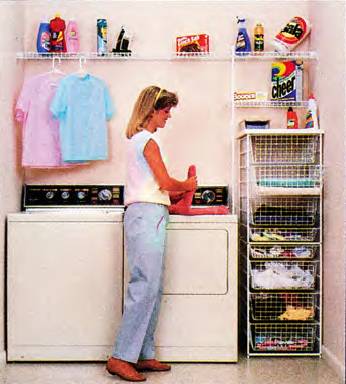
(left) Space in closets is maximized with wood and wire components. But use the space well: use a double row of hangers; put little-used items in remote areas of the closet.
(right) All-wire shelving and hanging, basket storage systems are an attractive way to transform an awkward space.
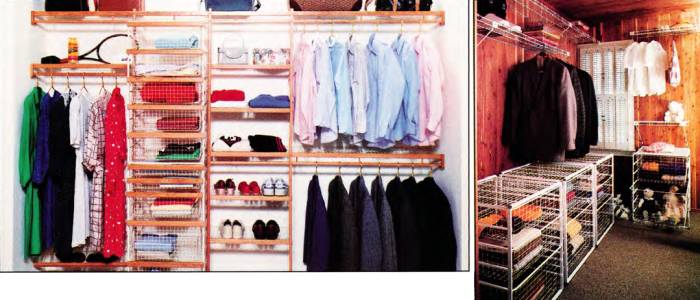
Cabinets aren’t only for kitchens. Installed in a busy workshop, a wall of drawers and cabinets is a stream-lined space-saver.
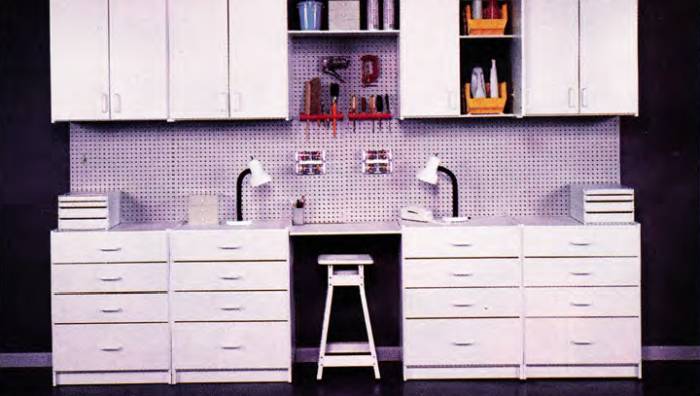
I know what you’re thinking.
“These suggestions all sound wonderful, but how can I reduce the clutter in my home? That’s what makes it feel claustrophobic. I’m not about to just pitch Aunt Bessy’s needlepoint cushions just because I can’t use them just now. I need storage space!”
I’m not suggesting a garage sale. Not yet.
First, peek inside those crowded closets, the ones that are so packed you’re afraid to open the door.
Pretty chaotic, eh?
Now you’re getting it. What you need is to get organized. And by that I don’t mean tidy up. We’re talking about a major restructuring of your storage space, so that every square inch gets used.
Look once more inside the closet. See how everything is stored in the middle? That’s because the middle is where the shelves are. You can change that. Add a shelf or two at the top and put the things you don’t often use up there — out of sight, out of mind! Goodbye to Aunt Bessy’s needlepoint cushions — until further notice.
Now look at the floor. You could use a shelf or two down there, too.
Shelves, baskets, hooks, hanger rods — all of these storage devices, installed in just the right places, may effectively triple the storage space in a single, hopelessly overcrowded closet.
The secret of storage
With more and more of us complaining about feeling not only overcrowded but overextended — in other words, disorganized — more and more manufacturers are coming to the rescue with ingenious new products. Ingenious and attractive solutions exist in a range of shapes, sizes, styles, and materials from melamine to metal.
If you’re basically organized you can apply some common sense and restructure your closets yourself. But if you’re one of those people for whom lost car keys are a routine nuisance, you may need professional help. Storage is fast becoming a science, and salespeople at stores selling storage products can steer you to invaluable shortcuts.
Generally there’s no extra charge for a simple closet design. As for the products themselves, they vary depending on the materials. The average six-foot closet costs around $200 to fill with a state-of-the-art wire storage system. Keep in mind though, that wire systems are about half the cost of wood systems.
Mirrors
Double the apparent size of a room by using two pairs of mirrored doors. In this case, they also eliminate the eyesore pair of metal bifolds. Great for bedroom, mirrored closet doors (bifold and sliding) are available at most home centers.
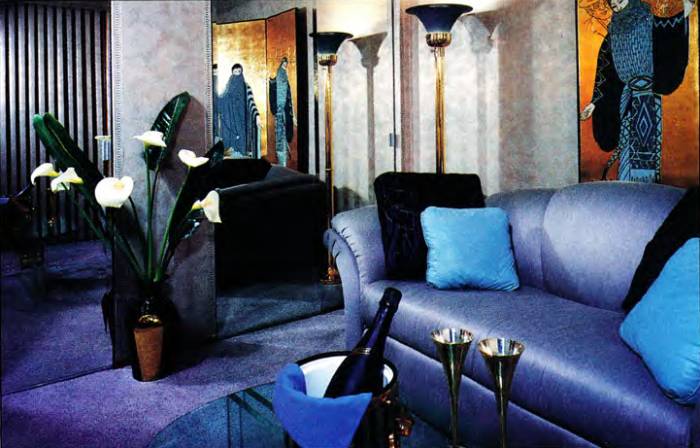
“Mirror, mirror, on the wall, can you make this room seem… not so small?”
The first step is to open your mind to the space-stretching potential of a simple sheet of reflective glass. Yes, the same material that graces the top of your medicine cabinet, the one that greets you each morning with your own rumpled image, splattered in toothpaste.
In the beginning, mirrors were made for small spaces, not medicine chests. Mirrors are illusionary gifts to small rooms, making them seem twice as big, twice as interesting, at a tiny fraction of the cost of actually pushing out those walls and filling up the new space with furniture.
A do-it-yourselfer can install closet doors that come complete with full-length mirrors attached. A couple of these will transform your utilitarian bedroom into an elegant boudoir.
Expect to pay around $200 for a four-foot, standard height mirrored sliding door. And then, be prepared to want a mirror in every room in the house.
Do you sometimes think you’re outgrowing your home? Did the rooms seem much bigger when you moved in? Whatever happened to all that space?
No. your home isn’t shrinking before your eyes. It just feels that way. If the cramped rooms in your house or apartment are reminding you all too often of the dimensions of your decorating budget, we have some ideas for you to change all that — without moving a wall or raising the roof. You can create the illusion of more space, and save the expense of that pricey addition.
I rounded up four of the easiest, most ingenious, and least expensive solutions ever found to the space-crunch problem.
One of these sleight of hand solutions may well be the answer to your space crunch. Or, if you’re really clever, you may put all four to work in your home.
Color
Focus attention on decorative elements (bright white woodwork, shutters, wicker furniture, pictures, etc.) by painting the walls a deep navy blue to make them visually recede. This creates an illusion of greater depth and the room feels bigger because the walls have, in effect, disappeared.

White walls can enlarge a room as well, but for different reasons. In this room a monochromatic color scheme of creamy off-white walls and furniture offers a sense of spaciousness through a minimum of clutter.

The most common technique for changing the apparent shape and size of a room is changing its color. Two gallons of paint, a few hours work, and presto! — you have a whole new look.
The lighter the color, the bigger the feel of the room, right? Well, not exactly. There‘s more to color than meets the eye.
For the last twenty years, the typical remedy for a room diagnosed as too small has been to paint everything (walls, ceilings, moldings) a dazzling white. But flat-out, pure white isn’t exactly a warm color, is it? Besides, it gets boring. Here are some alternatives.
Two alternatives to white
You want a bigger-looking room, but do you also want the color to lend warmth and visual interest? To set a mood? To complement your furnishings?
To begin with, keep in mind that if your rooms are making you feel claustrophobic, chances are it’s more than merely their size that’s bothering you. You may be reacting to a displeasing color scheme. That’s a snap to change.
Decorated tastefully and with an eye to maximizing the look of its space, you’ll feel more at ease, more likely to sit down in the room and enjoy yourself, stretch out and relax.
A very light color can be just as effective as white when it comes to your first requirement: creating the illusion of space. For a warmer, more intimate atmosphere, choose an off-white, a cream or ivory.
Remember the rule about clutter: it makes a room feel smaller. The same applies here. Don’t clutter your color scheme either. Paint everything — wall, ceilings, and woodwork — the same color. This approach works best if your carpet and furnishings are very light, too.
If you wish the color to assert itself a bit more — perhaps to harmonize with furnishings or to offer a muted back- ground for a particular accent color in the room, you can add a very pale tint and still preserve the illusion of more space. It’s the uniform lightness of the color scheme that lends the feeling of spaciousness.
But remember that the tint should be so light as to be almost imperceptible. Say, for instance, you add a hint of pink to the paint. You will sense its presence in the room — pink even in minute doses flatters skin tones and softens a room — but you wouldn’t call it a pink, or even a pinkish room. You would call it white.
My second suggestion may surprise you. Dark colors can open up a small room by making the walls appear to recede from your eye.
Caution: This technique takes confidence and a sure touch. It works only in rooms with lots of windows and light, and the higher the ceiling the better. Plus, the room should be able to accommodate a few fairly large pieces of furniture and artwork.
OK, the principle at work here is the same one you apply when buying clothes: Very dark colors tend to make you look thinner; bright colors have the opposite effect, drawing the eye immediately to them and to your body!
Paint the walls and ceiling a dark color, and watch them seem to recede behind those bold objects in the room. When this works, it works very dramatically. The walls and ceiling become backdrops to the objects in the room, rather than backstops for the eye, and you notice the objects rather than the walls.
Cool colors such as dark blue and dark green are particularly effective, especially if used on one wall only. Very deep reds and corals will accomplish the same thing as the cooler blues and greens, but red tones can have the reverse effect if you’re not careful to choose very dark shades. A bright red room or a bright blue room will both seem smaller than a dark red or dark blue room.
Deep-tone colors are more 60-70% expensive, compared to flat white latex. But when you compare these prices to the cost of that new addition…
Table 1: Warm Colors
These warm, cheerful colors make objects advance towards the eye so rooms appear smaller and furniture appears larger.
| Color | Effects | Overuse | Room Use |
|---|---|---|---|
| Warm Greys | Warm to neutral | Monotonous | Use with other colors |
| Yellows | Cheery, lively | Alarming | Bedroom, living room |
| Oranges | Can make people leave an area | Alarming | One wall |
| Reds, corals | Stimulates conversation, activity | Distracting, frantic | Dining, living, or conversation areas |
| Deep reds | Enticing, romantic | Intense | Dining, living, or conversation areas |
| Browns | Restful | Confining, dark | Study or use with other colors |
Table 2: Cool Colors
These cool, restful colors make objects recede from the eye so rooms appear larger and furniture appears smaller.
| Color | Effects | Overuse | Room Use |
|---|---|---|---|
| Cool greys | Heavy, melancholy | Chilling | Use with other colors |
| Greens | Relaxing, sedative | Melancholy, sad | Study or quiet areas |
| Blues/Turquoises | Restful, increases ability to concentrate | Melancholy, sad | Study or quiet areas |
| Mauves, purples | Calming, soothing | Depressing | Bedroom |
Table 3: Neutral Colors
These colors recede into the background and the eye focuses on the furniture and objects in a room.
| Color | Effects | Overuse | Room Use |
|---|---|---|---|
| White | Blue-whites are cool, yellow-whites are warm | Stark | Any room |
| Black | Dramatic | Cold, closed-in | Use with other colors |
| Taupes | Tend to be warm | Monotonous | Any room, use with other colors |
Moldings
Furniture that seemed too big for this room when the walls were white, fell right when “anchored” to deep green wallpaper bordered by moldings, and white paint. This scheme lends interest and organization to the room by giving the eye directions for where to go next.

Transform a claustrophobic hallway with moldings. Note the placement of moldings just below the eye level, and the use of twin strips of wood separated by white space.

No room should be without moldings.
Wait a minute! Won’t they just add to the clutter? Won’t they make an already small living room seem even tinier?
I’m not contradicting myself. Moldings have just the opposite effect. They accent and enhance a room‘s natural gifts, its scale and proportion, its immaculate lines and no-nonsense right angles.
Trace the lines where walls meet ceiling or floor with a simple wood molding, and you will not only add character and distinction to the room — you will also have tricked the eye into believing the room is bigger.
Really!
What’s more, moldings are inexpensive – be it a plain picture molding or a fancier crown molding. And you don’t need a master carpenter to install them. You can do it yourself. Check out my article about installing finish trim.
Where to install a chair rail
The most dramatic room-enlarging effect is created by a simple molding called a chair rail. The name comes from its original purpose, to protect walls, especially in dining rooms, from scrapes caused by chairs backed into them.
Any room in the house may be beautified by a chair rail, which is simply a strip of wood that horizontally bisects a room. The uninterrupted horizontal line entices the eye and thus seems to elongate the room. Very clever — and very easy to accomplish.
Your chair rail should be located just above or below major pieces of furniture (so they don’t hide it or interrupt the line). Pick a spot one third of the distance from the floor to the ceiling and you’re in the right neighborhood. Trace the line with masking tape and stand back far enough to measure the visual impact. Adjust the tape (take care to apply it gently) until you’re satisfied. Now you‘re ready to install the chair rail.
Stain or paint?
A natural finish on molding is attractive, but a painted finish will work harder to create the illusion of space in a small room. The point is not to focus attention on your space-stretching technique — in this case, wood moldings — but to create an overall effect of spaciousness.
Paint the trim—all the trim—in a satin or semi-gloss enamel. Off-white trim matching your off-white walls will do wonders for a small room, adding a touch of elegance that small spaces so often lack.
Storage
Giant-sized performance from a tiny laundry room, thanks to stacked wire baskets and combination rod and storage shelf placed above the washer/dryer.

(left) Space in closets is maximized with wood and wire components. But use the space well: use a double row of hangers; put little-used items in remote areas of the closet.
(right) All-wire shelving and hanging, basket storage systems are an attractive way to transform an awkward space.

Cabinets aren’t only for kitchens. Installed in a busy workshop, a wall of drawers and cabinets is a stream-lined space-saver.

I know what you’re thinking.
“These suggestions all sound wonderful, but how can I reduce the clutter in my home? That’s what makes it feel claustrophobic. I’m not about to just pitch Aunt Bessy’s needlepoint cushions just because I can’t use them just now. I need storage space!”
I’m not suggesting a garage sale. Not yet.
First, peek inside those crowded closets, the ones that are so packed you’re afraid to open the door.
Pretty chaotic, eh?
Now you’re getting it. What you need is to get organized. And by that I don’t mean tidy up. We’re talking about a major restructuring of your storage space, so that every square inch gets used.
Look once more inside the closet. See how everything is stored in the middle? That’s because the middle is where the shelves are. You can change that. Add a shelf or two at the top and put the things you don’t often use up there — out of sight, out of mind! Goodbye to Aunt Bessy’s needlepoint cushions — until further notice.
Now look at the floor. You could use a shelf or two down there, too.
Shelves, baskets, hooks, hanger rods — all of these storage devices, installed in just the right places, may effectively triple the storage space in a single, hopelessly overcrowded closet.
The secret of storage
With more and more of us complaining about feeling not only overcrowded but overextended — in other words, disorganized — more and more manufacturers are coming to the rescue with ingenious new products. Ingenious and attractive solutions exist in a range of shapes, sizes, styles, and materials from melamine to metal.
If you’re basically organized you can apply some common sense and restructure your closets yourself. But if you’re one of those people for whom lost car keys are a routine nuisance, you may need professional help. Storage is fast becoming a science, and salespeople at stores selling storage products can steer you to invaluable shortcuts.
Generally there’s no extra charge for a simple closet design. As for the products themselves, they vary depending on the materials. The average six-foot closet costs around $200 to fill with a state-of-the-art wire storage system. Keep in mind though, that wire systems are about half the cost of wood systems.
Mirrors
Double the apparent size of a room by using two pairs of mirrored doors. In this case, they also eliminate the eyesore pair of metal bifolds. Great for bedroom, mirrored closet doors (bifold and sliding) are available at most home centers.

“Mirror, mirror, on the wall, can you make this room seem… not so small?”
The first step is to open your mind to the space-stretching potential of a simple sheet of reflective glass. Yes, the same material that graces the top of your medicine cabinet, the one that greets you each morning with your own rumpled image, splattered in toothpaste.
In the beginning, mirrors were made for small spaces, not medicine chests. Mirrors are illusionary gifts to small rooms, making them seem twice as big, twice as interesting, at a tiny fraction of the cost of actually pushing out those walls and filling up the new space with furniture.
A do-it-yourselfer can install closet doors that come complete with full-length mirrors attached. A couple of these will transform your utilitarian bedroom into an elegant boudoir.
Expect to pay around $200 for a four-foot, standard height mirrored sliding door. And then, be prepared to want a mirror in every room in the house.
